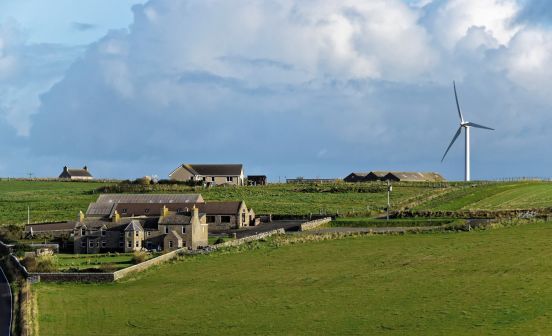News feature – Scottish Farmer
Date: 7th March 2019
Demand for On-shore Wind Farm Sites is back
The political appetite for renewable energy and on-shore wind farms is strong in Scotland and renewable energy developers have on-shore wind farm acquisition back in their sights.
In Scotland, over 70% of electricity generated, comes from renewable sources – two thirds of that is derived from wind.
Derek Bathgate of Davidson & Robertson (D&R) has fielded numerous enquiries over the past 6 months from several of the well-established renewable energy companies prospecting for sites to develop on-shore wind farms. The demand is specifically for sites in Scotland, not England, due to the different political appetites for renewable energy and on-shore wind farm development differing considerably.
On-shore wind makes up almost half the pre-operational renewable projects currently in the pipeline and developers are looking for more sites.
So, what exactly are the renewable energy companies looking for and how might land owners and occupiers (secure agricultural tenants have the right to benefit from such development too!) benefit from this opportunity?
What is important to developers? Sites that:
- have strong wind speeds
- are not dotted with residential properties
- lie outside high value environmental designations (National Parks, Ramsar sites, etc)
- are 400+ acres
- are close to grid capacity
- have good road access
Developers are interested in sites that have strong wind speeds, that lie outside areas with high value environmental designations (National Parks, Ramsar sites, etc) and are not dotted with residential properties. They are looking for land areas that are big enough to site at least 5 large wind turbines with tip heights at or above 100 metres, to achieve an installed capacity of at least 20 mega watts (MW). Typically, such an area would be 400 acres or more.
The renewables companies other critical success criteria are grid capacity and access to the site. Grid capacity is determined by the statutory provider in the area, either Scottish Power or SSE north of the border. This has been a restricting factor for many areas with wind energy potential, however recent infrastructure works around the country has seen the capacity improving, with new pylon lines being erected or old lines being upgraded.
Access to the potential site for development traffic is essential. Wind turbines are getting bigger, so the limiting factor of a site is being able to manoeuvre them into sites, e.g. getting the turbine blades around corners, or the construction cranes over bridges, etc. We are seeing more and more ingenious ways of getting such traffic to site, so these challenges can often be overcome.
Payments are still attractive. Current market payments from developers to land owners and secure agricultural tenants for hosting on-shore wind farm assets are no longer at the dizzy heights of recent years, because new sites are operating in a subsidy free market, but they remain very attractive and can provide a significant diversified income to a farm business. Payments are not just limited to annual rental for the wind turbines, nor to the land holding upon which the wind farm is built.
In addition to annual rental for wind turbines, the land owner/occupier hosting the wind farm can also benefit from: disturbance payments during the construction period, payment for rock and other aggregate won from site, rent from substations or anemometers and more.
Neighbours and nearby properties can benefit financially by enabling the grid connection (accepting the power line across their land) or agreeing to sell or rent land to widen the road that enables a turbine to get around a corner, or for a bridge to be strengthened, or a new one to be constructed.
There will be some reading this article who say, ‘we had a deal on the table, but it fell away when the subsidies stopped, and the developer walked away’. With the advances of technology – bigger turbines and more efficient machines – many sites that were written-off in the past, may now be financially viable for development.
D&R has seen the list of interested developers growing in the last 6 months. Land owners/occupiers who progressed discussions with developers that faltered when the subsidy regime came to an end, are advised to get these sites back in front of the current list of developers prospecting for new sites.
The key to a successful deal and maximising value is to engage Agents and Solicitors who understand these opportunities and the current market to negotiate Heads of Terms, Option and Lease agreements to your advantage. You should also include your Accountant in reviewing business structures and tax planning, enabling you to keep as much of the income and capital that can materialise from such deals.
D&R has significant experience and knowledge of this market, collaborating with other professional advisers to achieve the best outcome for clients. Negotiating commercial terms and keeping clients advised through the development process will ensure successful outcomes, both financially and on the ground during the construction phase.
Derek Bathgate is a Director at Davidson & Robertson – a company of Rural Surveyors and Consultants with nine offices across Scotland and Northern England.
To find out more about opportunities at Davidson & Robertson, visit www.drrural.co.uk.



